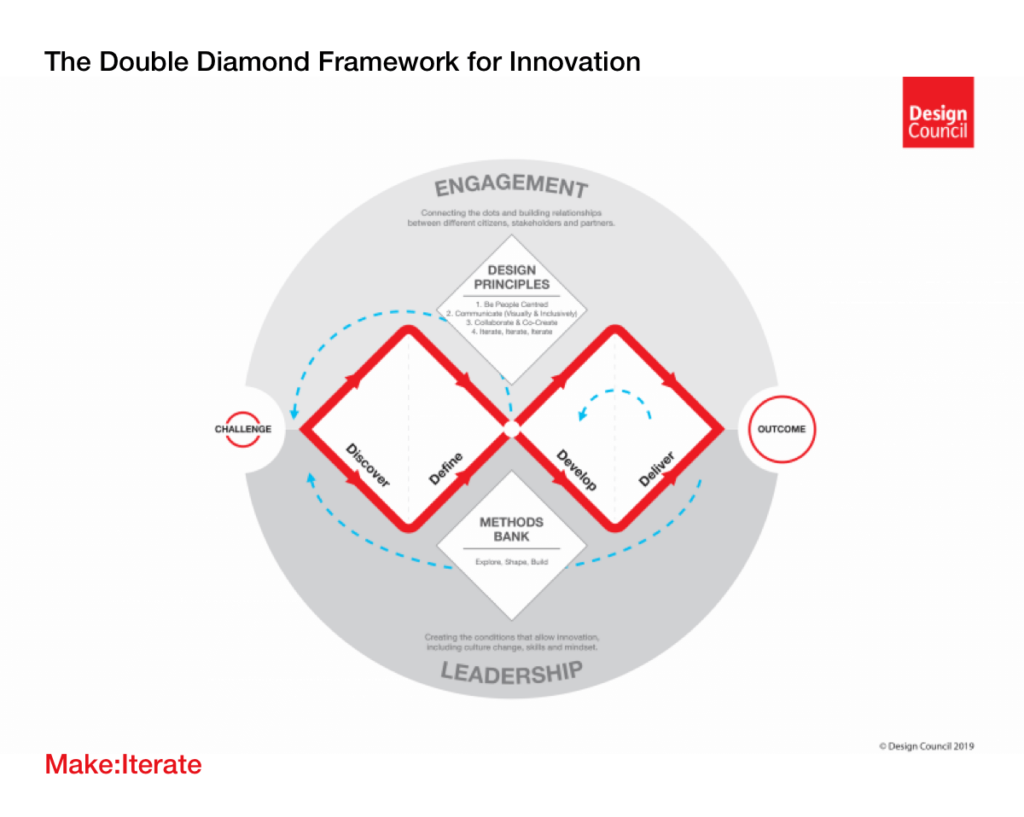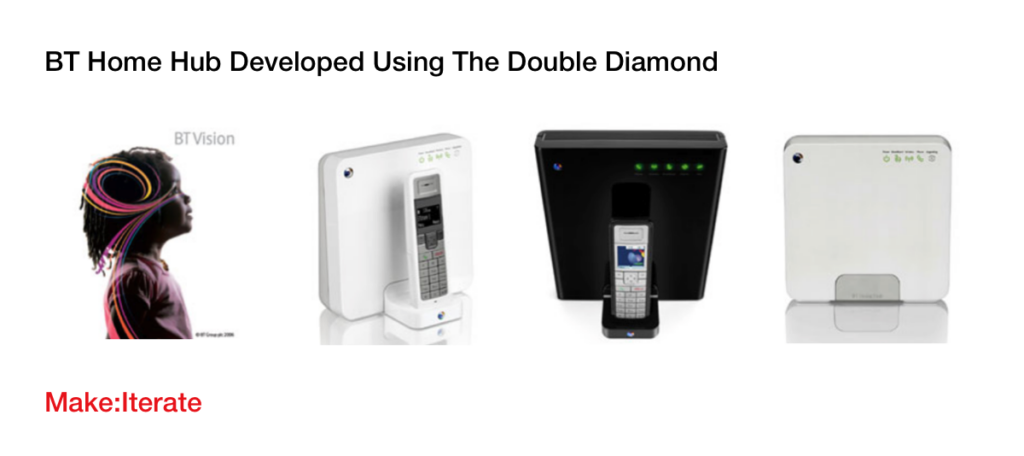The Double Diamond is a framework that guides the end-to-end design process.
It consists of 4 key phases and a set of principles that can help innovators to navigate even the most complex and ambiguous tasks.
It’s a framework based on the Design Thinking process that emphasizes understanding user needs and collaborating with a diverse group to find the right solution to the right problem.
In this article, we’ll explore the Double Diamond approach and how to put it into practice.
Did you know?
To help teams implement Design Thinking, we offer bespoke innovation training workshops. Talk with us and find out how we can help transform the way you design your products and services.
Interested? Message us in the bottom right corner or learn more here.

What is the Double Diamond Framework
The Double Diamond is a model for design thinking that helps innovators to navigate a design project from concept to completion.
The Double Diamond Design Model consists of four key phases:
- Discovery
- Definition
- Development
- Delivery
The shape of the two diamonds represents the principles of divergent thinking and convergent thinking: we go wide (Diverge) by gathering information and exploring widely, then narrow (Converge) by synthesizing our findings and making decisions.
The Double Diamond Design Model is a four-phase model used to identify customer problems and find innovative solutions.
The first Diamond involves getting a clear understanding of the challenges faced by real users by exploring the problem area through user research and eventually writing an actionable problem definition.
The second Diamond involves testing potential solutions to understand the problem area better while getting user feedback to help develop your potential solution.
The Double Diamond is not linear; designers go back and forth between the steps while problem-solving or improving existing solutions.
Both designers and non-designers can use the Double Diamond. It’s a problem-solving framework that can help anyone committed to creating solutions by understanding user needs.
The Design Principles
Innovation is all about people.
To be successful, problem-solvers should empathize with their users and collaborate inclusively to create a shared understanding of the issue at hand.
The best innovators are expert communicators and collaborators, and they frequently iterate – refining prototypes until they’re ready for development.
Problem-solvers should empathize with their users, collaborate inclusively to create a shared understanding of the issue at hand, and iterate frequently.

The Design Council outline 4 core principles for applying the Double Diamond:
1. Put people first: To truly craft an effective service, you must begin by recognizing your users as individuals with varying needs, abilities, and dreams. By taking a moment to appreciate their unique perspectives, you can create something powerful that resonates on many levels.
2. Communicate visually and inclusively: Helping people reach a mutual agreement about the issue and potential solutions is critical for making meaningful progress. By achieving shared understanding, individuals can think together to find the best way forward.
3. Collaborate and co-create: Collaboration is the cornerstone of success – it can spark creativity and provide invaluable inspiration. By seeing what others are achieving, we become catalysts for our progress; together, we learn, innovate and grow.
4. Iterate, iterate, iterate: For inspiring innovators, iteration is critical. Systematically refining an idea helps you identify missteps early, reduce risk and bolster confidence in the outcome. Iterative optimization can be a powerful ally for any creator taking brave leaps into uncharted territory.

The Double Diamond and Design Thinking
The Double Diamond is a practical framework for applying Design Thinking.
It provides organizations with a clear set of steps to use this mindset and ensure that teams of people from different disciplines and specializations better understand each other’s perspectives and move towards actionable results.
The Double Diamond is a practical framework for applying Design Thinking that provides organizations with clear steps to use this mindset.
Design Thinking goes beyond just concepts and ideas – it requires diverse approaches from the whole team to create the best outcomes.
The Double Diamond informs the innovation process and other similar design methods, such as the D.school’s approach to Design Thinking, Design Sprint, and the Design Cycle.
If we look deeper into these structured frameworks, organizations can unlock true innovation through collaborative problem-solving with clarity in direction.
How to apply the Double Diamond framework
With the Double Diamond, design practitioners can confidently tackle their most complex projects.
Comprised of four stages and an array of tools and techniques to use along each journey, even the most complex projects can be reduced to a series of clearly defined stages.
Each stage has its own considerations: Discovering where to start; Defining what needs to be done; Developing creative solutions that work best for users; Delivering great ideas into production-ready formats.
1. Project kick-off and initiation
Kick-offs create the starting line for your team and client’s journey.
This meeting sets expectations, aligns vision between parties, and provides guidance to ensure everyone is on track toward collaborative success!
2. Discover the problem area and gain insight into user needs
The Discovery stage is about understanding the problem that must be solved.
This stage involves research and analysis to identify the project’s key stakeholders, user needs, and objectives.
3. Define the problem and articulate the design challenge
The Definition stage is about generating ideas and potential solutions to the problem.
This stage involves brainstorming, mind mapping, and other creative techniques to generate and develop a wide range of ideas.
4. Develop and test a range of innovative ideas
The Develop stage is about going broad with ideation to explore a range of different solutions before narrowing down the ideas and developing a prototype or proof of concept for the chosen idea.
This stage involves testing and refining the chosen solution until it is ready for implementation.
5. Deliver your solution through focused action
The Deliver stage is about implementing the chosen solution and ensuring it meets the user needs and objectives identified in the defined location.
This stage involves creating a plan for implementing the solution and ensuring that it is executed flawlessly.
6. The Methods Bank: An archive of tools and techniques
A methods bank can be an invaluable resource for any design team.
It is an archive of tools and techniques from which the team can draw at any stage in the design cycle, ranging from exploration to refinement.
Essentially, it helps with unlocking creative ideas through proven methods and activities.
A method bank is a collection of tools and techniques that can be used by a team during the design cycle.
These days many teams keep a method bank handy as a wiki page or even a wiki I page as part of a more extensive Design System.
For those looking for already established method banks, several are available online, each offering its unique selection of ideas and approaches.
Notable method banks include:
- Ideos design thinking toolkit
- IBM design thinking toolkit
- D.School design thinking for educators
7. Creating the conditions for the design to thrive
Design is not a solo effort but can be likened to a team sport.
It requires highly collaborative efforts and support from all areas of an organization to be effective.
Senior management and leadership play an essential role in design success by providing resources and capabilities and cultivating the right culture for design to thrive.
Design is most successful when it is collaborative, with everyone in an organization supporting it.
Designers must also form connections with organizational stakeholders to ensure that each perspective and need is attended to when designing a product or service.
When senior management, leadership, and designers come together, design can have an enduring impact that addresses various stakeholder groups.
What Type of Projects Is the Double Diamond Suitable For?
The beauty of the Double Diamond is that it can guide most types of design projects.
The very fact that it values learning and experimentation over making assumptions, is what makes it a fluid and adaptable framework that can guide most projects.
Here are 9 examples of when the Double Diamond works best:
- When your leadership team value human centered design
- When you need help navigating a complex design challenge
- When your project requires exploration to define complex or wicked problems
- When your project requires a deep understanding of user needs
- When your project is complex and will require rounds of iteration
- When you don’t have a knowledge base of user insight and need to build one
- When you have a knowledge base of user insight, and you need to update it
- When you need to innovate using one of the four types of innovation
- When you need a structure to align multiple teams and experts
How Is the Double Diamond Different From Other Methods?
The Double Diamond is unique in articulating the idea of divergence and convergence.
The idea that there is a time for exploration, a time for decision-making, and a time for focused action, is an idea that can be applied to any ambiguous process with some success.
The Double Diamond shares principles with Human Centered design, such as an emphasis on user research, collaboration, and iteration.
It’s easy to get lost in the weeds when there are so many variables and data points to consider. By keeping in mind the idea of divergence and convergence, we can navigate even the most complex and ill-defined problem spaces.
What sets The Double Diamond apart from traditional analytical thinking are the principles that it shares with Human Centered design – its emphasis on user research, collaboration, and iteration.
The New Double Diamond Method: A Framework for Innovation
For over 15 years, the Double Diamond has been used to describe the design process to designers, clients, and stakeholders.
The simplicity of the infographic conveys the complex ideas and methods that design functions have used for a long time in a concise and easy-to-digest format.
In 2019 The Design Council updated the Double Diamond model to include elements that describe the mindset, methods, and culture required to execute the design process effectively.
These new elements – outlined earlier in this article – were Engagement, Leadership, Design Principles, and Method Banks.
These significant additions to the framework show how influential culture and capability enable designers to do their best work.
No matter how good the practice is, if they don’t have the support of the organization and the conditions for innovation, then no version of the design process can be effective.

Example of the Double Diamond in Action
BT launched its Home Hub product and demonstrated how they strategically leverage design as an integral aspect of its brand.
This broadband router is designed with Voice Over Internet Protocol (VOIP) capabilities and even includes a phone handset for added convenience.
To combat changes in the broadband market, they needed to emphasize the additional features that came as part of its service offerings – enter The Home Hub.
BT responded with lightning speed to a dramatic change in the broadband market. A competitor had started offering free-of-charge lines, which posed an obvious threat to their business model, including charging subscribers fees every month for their services.
To combat these changes, they needed to emphasize the additional features that came as part of its service offerings – enter The Home Hub.
Mercer and the design team had a tremendous challenge ahead of them: they were asked to dramatically alter an existing router device, making it appealing and easy for consumers.
But despite these obstacles, their success was extraordinary – by turning the unit onto its end, adding a cradle for telephone handsets, cleverly managing cables within the product’s build structure as well as innovating modern packaging design with elegant presentation techniques that yielded logical setup procedures; Mercer delivered on his objective of providing BT customers with an indulgent experience from advertisement all way through the installation process.
Why Was the Double Diamond Process Developed?
The British Design Council wanted to promote the value of strategic design and design management.
To fulfill its mission of showcasing the true power of design, Design Council needed to define a process that could help everyone understand it.
In 2003, Richard Eisermann – Director of Design and Innovation at Design Council- posed an important question: “How do we package up our message on how great design works?”
The process was created by reviewing the design processes at a number of top companies and finding similarities across each function.
His inquiry was designed to unlock people’s understanding of the transformative nature of good design management practices.
They reviewed the design processes at a number of top companies and found similarities across each of the functions.
This led to the development of the Double Diamond Design process which is now widely used throughout UX design, service design, industrial design, and UX research as a guide to navigating the problem space and creative process.
Conclusion
The Double Diamond is a model for design thinking that helps innovators to navigate a design project from concept to completion.
The shape of the two diamonds represents the principles of divergent and convergent thinking: we go wide (Diverge) by gathering information and exploring widely, then narrow (Converge) by synthesizing our findings and making decisions.
Design Thinking goes beyond just concepts and ideas – it requires diverse approaches from the whole team to create the best outcomes.
The double diamond informs this process and other similar methods, such as the d.school’s approach to design thinking, Design Sprint, and the design cycle.
The Double Diamond design thinking approach is an invaluable tool for UX designers and those looking to design the right thing for the right problem.
It offers structure and guidance throughout the journey from problem definition to possible solution, ensuring that no stone is left unturned when it comes to exploring the solution space.
It encourages creativity and allows us to use research-driven insights in order to curate experiences people value, rather than just creating something for the sake of it.
By following the four steps outlined in double diamond design thinking, Design Thinkers are empowered to meet user needs time and time again.


